engine AUDI Q7 2014 Owner´s Manual
[x] Cancel search | Manufacturer: AUDI, Model Year: 2014, Model line: Q7, Model: AUDI Q7 2014Pages: 340, PDF Size: 85.02 MB
Page 239 of 340

Driving off road
Driving in difficult road
conditions and offroad
General information
The operation of the E lectronic Stabilization
Control (ESC) is expanded fo r operation away
from paved roads. In situations where slip or a
differential lock ing funct ion is required, the
offroad mode can be activated
c:::> page 224.
Hill descent control is a lso ava ilable in the off
road mode, which automat ically brakes the
ve hicl e and thereby keeps speed consta nt
when differe nt w heel speeds a re detected
when descending a hill
c:::> page 226. Your A ud i
a lso has permanent a ll-wheel drive in addi
tion.
H oweve r, your Aud i is not a pure off road ve hi
cle . It was not built for d riving unde r extreme
conditions, e.g. for trips that are in the nat ure
of an expedition .
Drive only on road s and offro ad sections
which match the de sign of y our vehicl e and
you r abilitie s as a dri ver. Ne ver t ake ri sks!
Before driving offroad
- Check the eng ine oi l level, t ire pressu re ,
coolant level , and the fluid level in the w ind
shield washe r reservo ir.
- Stow luggage items a nd other objects in the
l uggage compartment, and sec ure t hem
against s lid ing aro und .
After driving offroad
- After trips off road, remove any twigs and
othe r foreign objects from the grill , the un
derbody and the wheels. Pay spec ia l atten
t ion to fore ign ob jects (stones) which have
become lodged in t he tire tre ad.
- Clean t he body and the vehicle unders ide,
and inspect the veh icle for possible damage.
- Clean dirty w indows , headlamp lenses, rear
li gh ts, and license plates .
- Perfo rm a brake check (particularly after
t ravell ing throug h water) .
Driving off road 237
A WARNING
-Drive especially attentively and plan
ahead in diff icu lt road conditions and
when off road. Excessive speed o r inco r
rect maneuve rs can cause injuries and
damage to the vehicle.
-
- Always adapt your speed and driving
style to road, offroad, t raff ic, and weath
e r condition s. D rive e spe cially slowly off
road when yo ur view is restricted.
- Please be aware that in offroad mode,
pa rti cularly on a smoo th and s lippery
road, the whee ls may have an increased
tendency to spin and the vehicle may
break away -danger of skidding!
- Stability is limited in the offroad mode .
@ For the sake of the environment
Avoid damage to the environment and re
spect na ture .
@ Tips
Only d rive where it is permitted and stay
on marked roads and paths.
Explanation of some technical terms
T he following data refer to ideal cond itions .
Depend ing on ve hicle load and gro und condi
tions and the environment, the numbers may
vary .
It is the driver's responsibility to decide
whether a veh icle can overcome a specific sit
uat ion
c:::> &, .
Gradient angle
The number o f meters in altitude ga ined over
a distance of 109.4 ya rds or 100 meters
(grade) are given as a percentage o r degrees.
Information about the gradient the vehicle
can climb under its own power (depends in
part on the road surface and engine power).
Max imum perm itted grade : 31
°
Lat eral angle (slo pe of veh icle )
Indicates the angle up to which the vehicle
can be driven diagona lly or across the fall line
on a slope without the vehicle tipp ing over
IJll,
•
•
Page 241 of 340
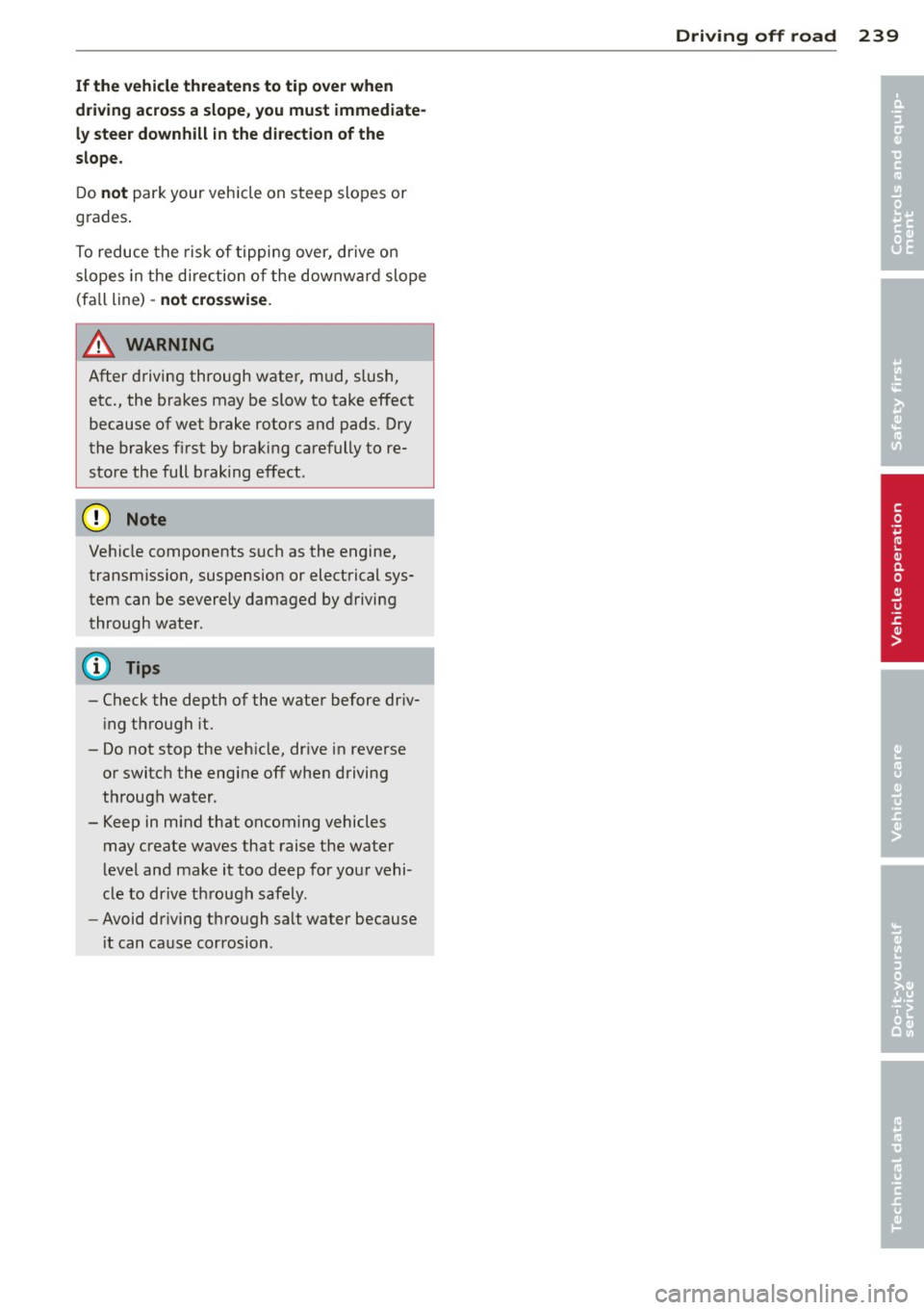
If the vehicle threaten s to tip o ver when
d riv ing across a slope , you mu st imm ediate
ly steer downhill in the di rection of the
slope.
D o not park your vehicle on steep slopes or
grades .
To reduce the risk of t ipping over, dr ive on
slopes in the d irection o f the downward slope
(fa ll line) -
not cro sswi se.
~ WARNING
After driving through water, m ud, slush,
etc., the brakes may be slow to take effect
because of wet brake rotors and pads. Dry
the brakes first by braking carefully to re
store the full braking effect.
(D Note
-
Vehicle components such as the engine,
transmiss ion, suspension or electrical sys
tem can be severely damaged by driving
through water.
{l) Tips
- Check the depth of the wate r before dr iv
i ng through it.
- Do not stop the veh icle, dr ive in reverse
or switc h the engine off when driving
t h rough water.
- Keep in mind that oncoming vehicles may create waves that raise the water
leve l and make it too deep for your vehi
cle to drive through safely.
- Avoid dr iving through sa lt water because
i t can cause corrosion.
Driving off road 239
•
•
Page 243 of 340

Weight Rating will also change the per
formance and handling characteristics of
your vehicle, which could cause a crash resulting in serious injury or death .
- The Gross Vehicle Weight Rating for your
vehicle would be exceeded if your vehicle
is simultaneously equipped with Panor
amic sliding sunroof; third-row seating;
trailer towing equipment (factory or
dealer-installed), and running boards
(dealer-installed) . UNDER NO CIRCUM
STANCES MAY ALL SUCH ITEMS BE IN
STALLED ON THE SAME VEHICLE.
Operating instructions
MAX 6.9"
MAX175mm
E
1/1 E 1/1 ... a)
m
Fig. 231 Perm itted ba ll posit ion of the trailer hitch
Trailer towing weights
With a factory-installed trailer hitch, the
maximum permissible trailer weight is 6,615
lbs (3,000 kg). The maximum permissible un
braked trailer weight is 1,650 lbs (750 kg).
With an
aftermarket trailer hitch, the maxi
mum permissible trailer weight is 5,512 lbs
(2,500 kg). These specifications apply when
driving on roads having an incline of less than
12%.
Permissible tongue load
For best vehicle handling under these
changed cond itions, adjust the trailer load so
that the tongue load is at the maximum al
lowable or slightly lower. You can get an ap
proximation of the tongue load with a bath
room scale or you can measure the load at a
trucking company or weighing station .
With a
factory-installed trailer hitch, the
maximum permissible load on the ball hitch Trailer towing 241
may not exceed 662 lbs (300 kg). With an
af
termarket
trailer hitch, the maximum permis
sible load on the ball hitch may not exceed
551 lbs (250 kg).
It is recommended to use
the maximum permissible load.
Trailer load distribution
Be sure the load in the trailer is held securely
in place to prevent it from shifting forward,
backward or sideways.
Never allow a passenger to ride in a trailer
¢ .& in Driving instructions on page 242.
Ball mount
The trailer hitch may only be used with suita
ble ball mount and ball ¢
fig. 231. Installa
tion of the hitch ball must be carried out in ac
cordance with the manufacturer's instruc
tions. At the height dimension of 1.5 in
(38.S mm) a tolerance of+/- 0.5 in (12. 7 mm)
is permissible.
Engine cooling system
Towing a trailer makes the engine work hard
er . It is important that the cooling system's
performance is up to the additional load.
Make sure that the cooling system has enough
fluid .
Tire pressure
When towing a trailer, inflate the tires of your
vehicle to the cold tire pressure listed under
"Full load" on the tire pressure label. The tire
pressure label is located on the driver's side B
pillar . Inflate trailer tires to trailer and tire
manufacturers' specifications .
Lights
The headlight settings should be checked with
the trailer attached before driving
off. Check
to make sure both vehicle and trailer lights
are working properly .
Safety chains
Be sure trailer safety chains are properly con
nected from the trailer to the hitch on the
ve
hicle. Leave enough slack in the chains to per
mit turning corners. When you install safety
Ill-
•
•
Page 244 of 340
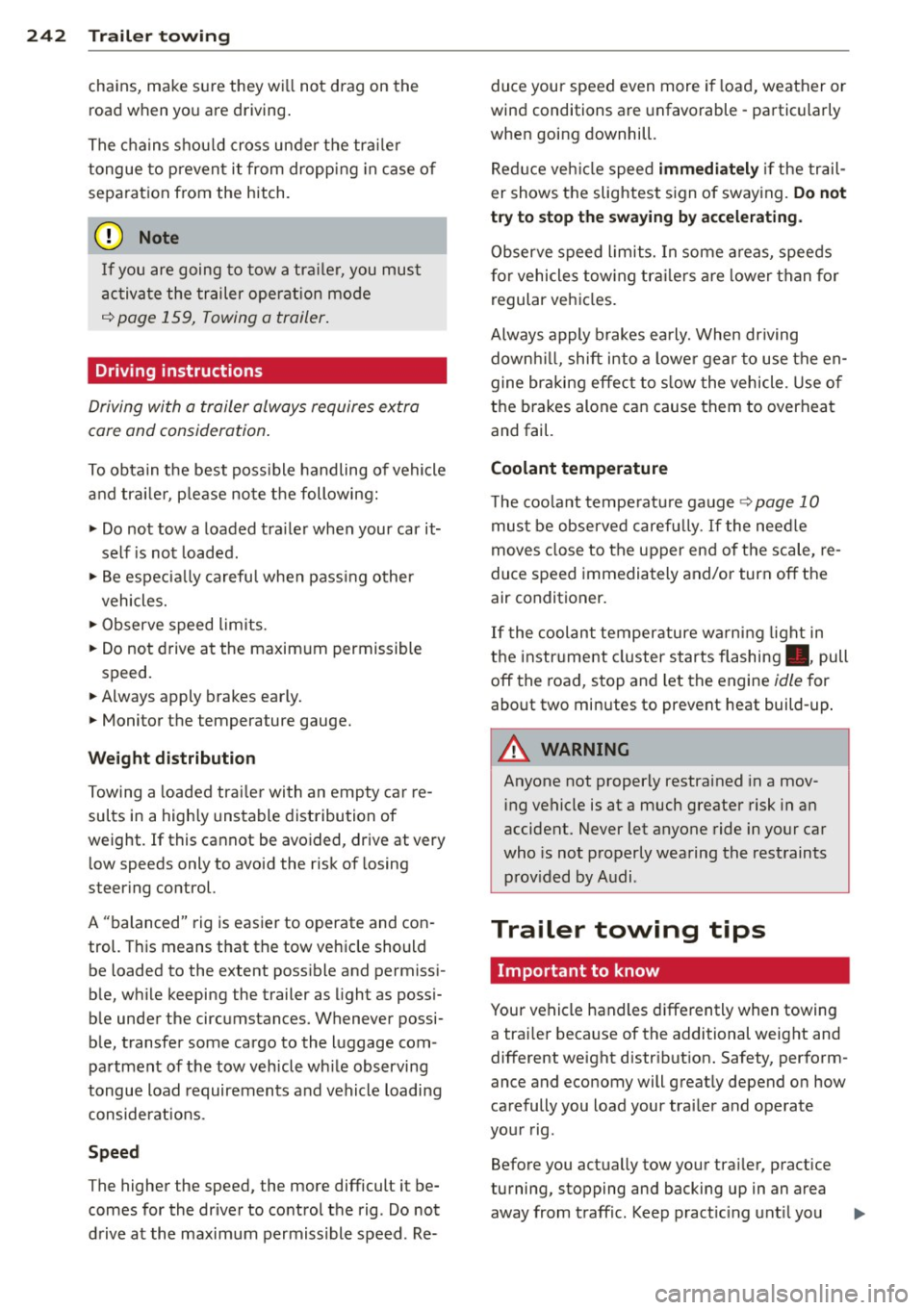
24 2 Trailer towing
chains, make sure they wi ll not drag on the
road when you are driving .
The cha ins shou ld cross under the tra ile r
tongue to prevent it from dropping in case of
separation from the hitch.
0 Note
If you are going to tow a tra ile r, you must
activa te the trailer operation mode
~ page 159, Towing a trailer.
Driving instructions
Driving with a trailer always requires extra
cor e and consid eration.
To obta in the best poss ible handling of vehicle
and tra ile r, p le ase no te the following:
.. Do not tow a loaded tra iler when your car it
self is not loaded.
.,. Be especia lly careful when pass ing othe r
vehicles .
.. Observe speed limits.
.. Do not driv e at the maximum p ermissible
speed.
.. Always apply brakes early.
.. Monitor the temperature gauge.
Weight di stributio n
Towing a loaded trai ler with an empty ca r re
sults in a high ly unstable distribution of
weight . If this cannot be avoided, drive at very
l ow speeds only to avoid the risk of los ing
steering control.
A "balanced" rig is eas ier to operate and con
trol. This means that the tow vehicle should
be loaded to the extent possible and permiss i
ble, while keeping the trailer as light as possi
b le under the circumstances. Whenever possi
b le, transfer some cargo to the luggage com
pa rtment of the tow veh icle wh ile observing
tongue load requirements and vehicle loading
considerations .
Speed
The higher the speed, the more difficult it be
comes for the driver to control the rig . Do not
drive at the maximum permiss ible speed . Re- duce your speed even more i
f load, weather or
wind conditions are unfavorable - particularly
when going downhill.
Red uce veh icle speed
immediately if the trail
er shows the slightest s ign of sway ing.
Do not
t ry to stop the swa ying by acceleratin g.
Observe speed limits. In some a reas, speeds
f or vehicles tow ing tra ile rs are lower than for
r egular vehicles.
Always apply brakes early. When driving down hill, shift into a lowe r gear to use the en
gine braking effect to s low the vehicle . U se o f
the brakes alone can cause them to overheat
and fail.
Coolant temperature
T he coo lant tempe ratu re gauge ~ page 10
must be observed caref ully. If the need le
moves close to the upper end of the scale, re
duce speed immediately and/or turn off the
air conditioner.
If the coolant temperature warn ing light in
the instr ume nt cluster starts flashing., pull
off the road , stop and let the engine
idle for
about two min utes to prevent heat build -up .
A WARNING "--
Anyone not proper ly restrained in a mov-
ing vehicle is at a much greater risk in an
accident. Never let anyone ride in your car
who is not properly wearing the restraints
p rov ided by A udi .
Trailer towing tips
Important to know
Your vehicle handles d ifferently when towing
-
a trai ler because of the additional weight and
different weight distr ibut ion. Safety, perform
ance and economy will great ly depend on how
ca refully you load your tra iler and operate
yo ur rig .
Before you act ua lly tow your tra iler, practice
turning, stopping and backing up in an area
away from traffic. Keep pract ic ing unt il you
Page 245 of 340
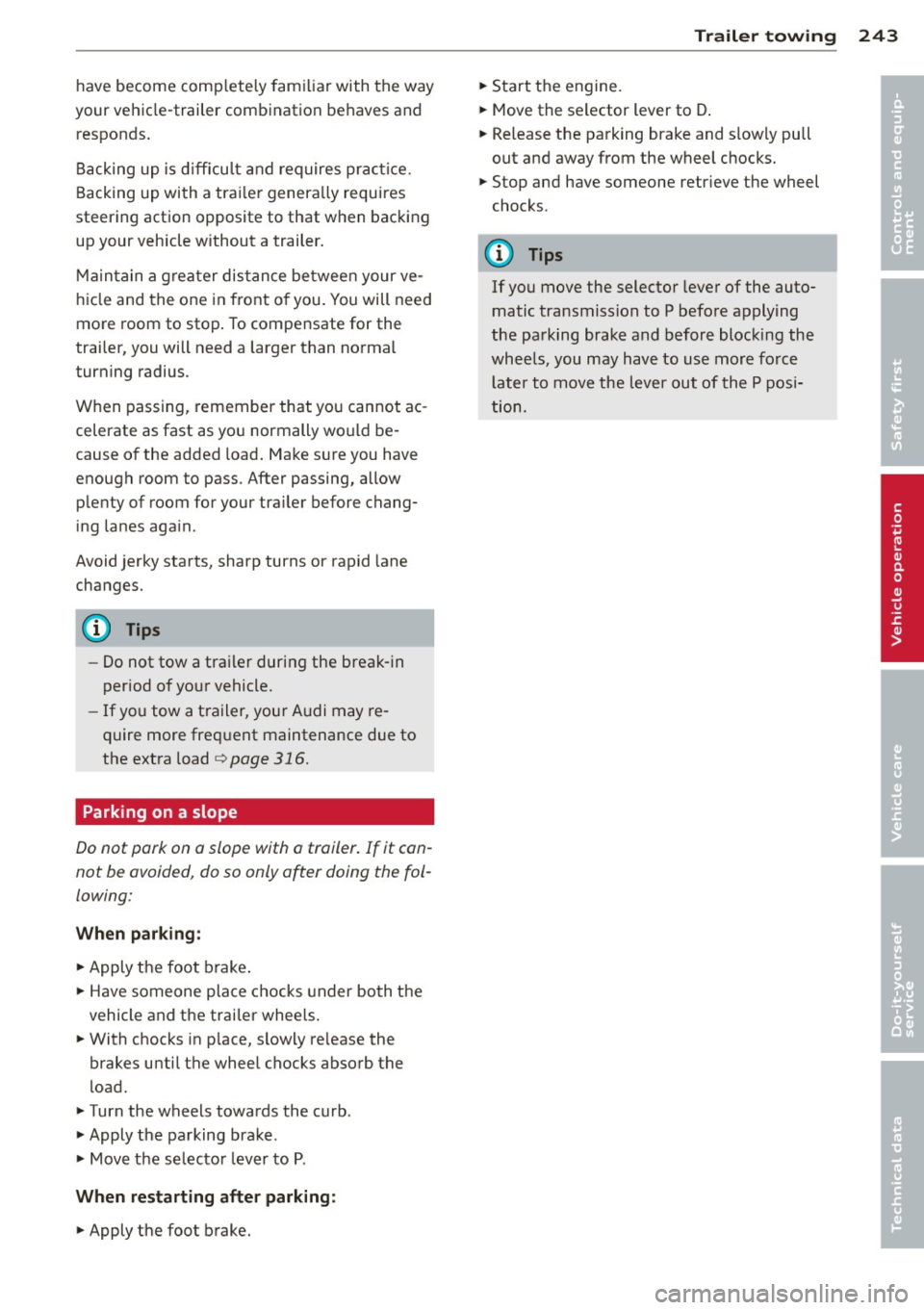
have become completely familiar with the way
your vehicle-trailer combination behaves and responds.
Backing up is difficu lt and requires practice.
Backing up with a trai ler genera lly requires
steering action opposite to that when backing up your vehicle without a trailer .
Maintain a greater distance between your ve
hicle and the one in front of you. You will need
more room to stop . To compensate for the
trai ler, you will need a larger than norma l
turning radius.
When passing, remember that you cannot ac
celerate as fast as you normally would be
cause of the added load . Make sure you have
enough room to pass. After passing, allow plenty of room for your tra iler before chang
ing lanes again .
Avoid jerky starts, sharp turns or rapid lane
changes.
@ Tips
- Do not tow a traile r during the break-in
period of your vehicle.
- If you tow a trailer, your A udi may re
quire more frequent maintenance due to
the extra load
<=> page 316.
Parking on a slope
Do not park on a slope with a trailer. If it can
not be avoided, do so only after doing the fol
lowing:
When parking:
.. Apply the foot brake .
.. Have someone place chocks under both the
vehicle and the trai ler wheels .
.. With chocks in place, slowly re lease the
brakes until the wheel chocks absorb the
load .
.. Turn the wheels towards the curb .
.. Apply the parking brake .
.. Move the selector lever to P.
When restarting after parking:
.. Apply the foot brake.
Trailer towing 243
.. Start the engine.
.. Move the selector lever to D.
.. Release the parking brake and s low ly pull
out and away from the wheel chocks.
.. Stop and have someone retr ieve the wheel
chocks.
(D Tips
If you move the selector lever of the auto
matic transmission to P before applying
the parking brake and before blocking the
whee ls, you may have to use more force
l ater to move the lever out of the
P posi
tion.
•
•
Page 251 of 340

Fuel supply and filling
your f uel tank
Fuel supply
Gasoline
Applies to vehicles: with gasoline engine
Using the right fuel helps keep the environ
men t clean and preven ts engine damage.
Fuel recommendation
The fuel recomme nded fo r yo ur vehicle is un
leaded premium
grade gasoline . A udi recom
mends using TO P TIE R D etergent Gaso line
w it h a m ini m um oc tane ra ting of 91 A KI (9 5
RON ). For more inform ation on TOP TIER De
tergent Gasoline, please go to the off ici al
websi te (www .to pt iergas .com) .
T he recommended gasoline octane rating for
your eng ine can also be fo und o n a label loc at
ed o n the ins ide of the fuel filler flap . This ra t
i ng may be specified as AK I or RO N.
Your veh icle may also be operate d using un
l ea ded regular gasoline with a min imu m oc
tane rating of 87 AKI/91 RO N. However, using
87 AK I/91 RON octa ne f ue l w ill sli ghtly re
d uce eng ine perfo rmance .
Use unleaded gasoline only . Unleaded gaso
line is available th rougho ut the USA, Canada,
an d in most E uropean cou ntries . We recom
mend that you do not ta ke yo ur vehicle to
areas or countries where unleaded gasoline
may not be ava ilable.
F or more informat io n on refue ling your ve hi
cle, see
q page 251.
Octane rating
Octane r ating ind icates a gaso line' s ability to
r es is t engine d am ag in g "kno ck" c aused by
p remature ign ition and detona tion. Therefore,
buy ing the correct grade of gaso line is very
importa nt to he lp prevent possible engine
damage and a loss o f engine performance.
G asoline mos t commonly used in the Unite d
States an d Canada has the following octane
Fuel supply and filling your fuel tank 249
rat in g s that can usu a lly be found on the fi ller
pump :
- Premium Gr ade: 9 1 -96 AKI
- Regular Grade: 87 - 90 AKI Explanation of the abbreviations:
AKI = Anti K nock In d ex = (R+M )/2 = (RO N
+MON )/2
RON= Resear ch O ctane Num ber
MO N = Motor Octane Number.
(D Note
- Do not use any fue l w ith octane rat ings
lower than 87 A KI or 9 1 RO N othe rwise
e xpensive engi ne damage w ill occur.
- Do
not use leaded gasoli ne . The use of
leaded gasoline w ill severely damage
yo ur vehicl e's cata lytic conve rter a nd its
abi lity to control exh aust em issions.
Blended gasoline
App lies to vehicles: wi th gaso line engine
Use of gasoline containing alcohol or
MTBE (methyl tertiary butyl ether)
You m ay use unlea ded gasoline blen ded wi th
alcohol o r M TB E (commonly referred to as
oxygenates) if the blende d mixture meets the
f o llow ing criteria:
Blend of gasoline methanol (wood alcohol or
methyl alcohol)
- Anti -k n ock index mus t be 87 A KI or higher.
- Blend must contain no mor e than 3% meth-
anol.
- Blend must contain more than 2% co-sol-
vents .
Blend of gasoline and ethanol (grain alcohol
or ethyl alcohol)
- Anti -knoc k index must be 87 AKI or h igher.
- Blend must not co nta in mo re tha n 10 %
ethanol.
Blend of ga soline and MTBE
- Anti-knock index must be 87 AKI or high er. ..,.
•
•
Page 252 of 340
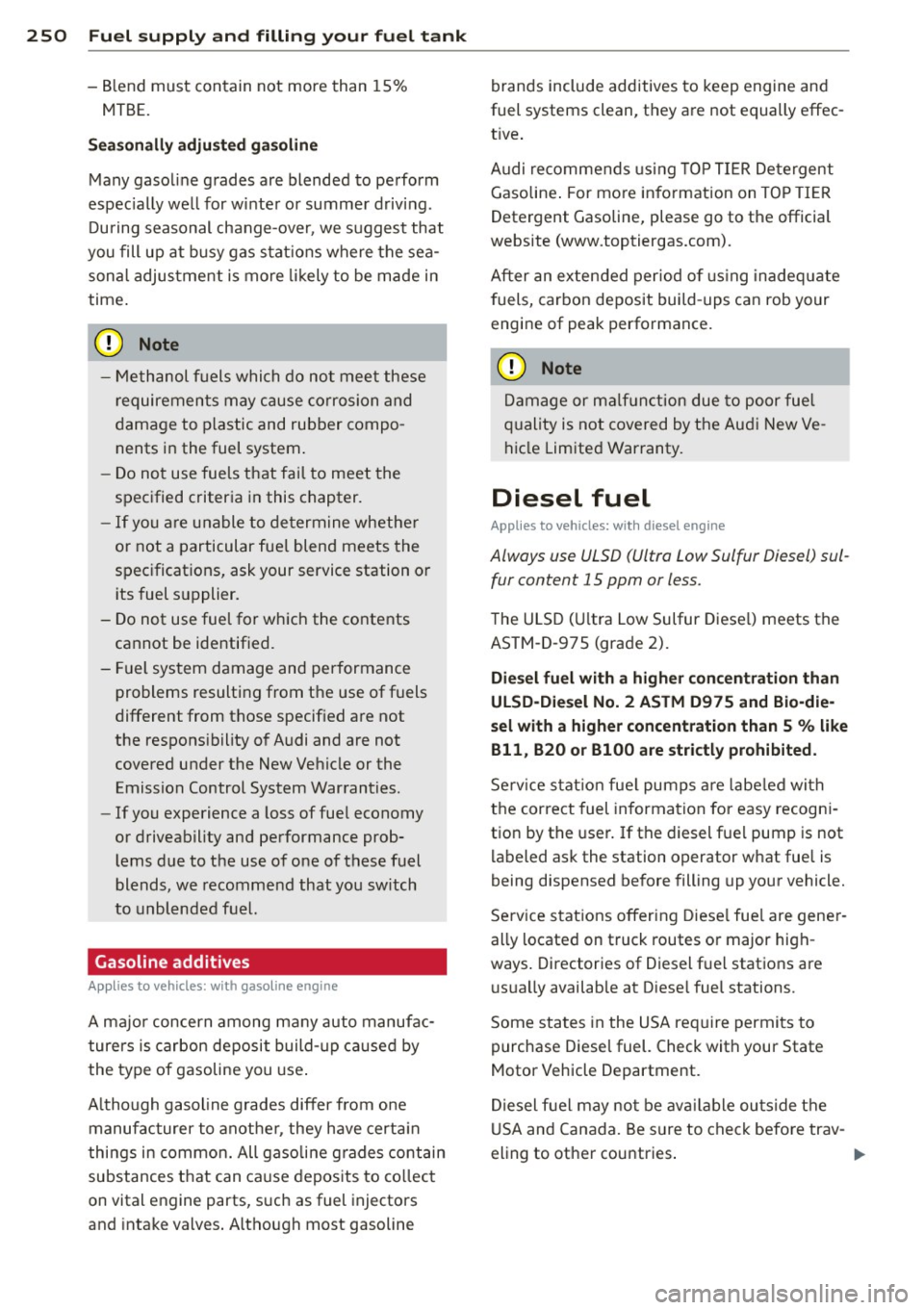
250 Fuel supply and filling your fuel tank
-Blend must contain not more than 15%
MTBE.
Seasonally adjusted gasoline
Many gasoline grades are blended to perform
especially well for winter or summer driving. During seasonal change-over, we suggest that
you fill up at busy gas stations where the sea
sonal adjustment is more likely to be made in
time.
(CT) Note
- Methanol fuels which do not meet these
requirements may cause corrosion and
damage to plastic and rubber compo
nents in the fuel system.
- Do not use fuels that fail to meet the
specified criteria in this chapter.
- If you are unable to determine whether
or not a particular fuel blend meets the
specifications, ask your service station or
its fuel supplier.
- Do not use fuel for which the contents cannot be identified.
- Fuel system damage and performance
problems resulting from the use of fuels
different from those specified are not
the responsibility of Audi and are not
covered under the New Vehicle or the
Emission Control System Warranties.
- If you experience a loss of fuel economy
or driveability and performance prob lems due to the use of one of these fuel
blends, we recommend that you switch
to unblended fuel.
Gasoline additives
Applies to vehicles: with gasoline engine
A major concern among many auto manufac
turers is carbon deposit build-up caused by
the type of gasoline you use.
Although gasoline grades differ from one manufacturer to another, they have certain
things in common. All gasoline grades contain
substances that can cause deposits to collect
on vital engine parts, such as fuel injectors
and intake valves. Although most gasoline brands include additives to keep engine and
fuel systems clean, they are not equally effec
tive.
Audi recommends using TOP TIER Detergent
Gasoline. For more information on TOP TIER
Detergent Gasoline, please go to the official
website (www.toptiergas.com).
After an extended period of using inadequate
fuels, carbon deposit build-ups can rob your
engine of peak performance.
(D Note
Damage or malfunction due to poor fuel
quality is not covered by the Audi New Ve
hicle Limited Warranty.
Diesel fuel
Applies to vehicles: with diesel engine
Always use ULSD (Ultra Low Sulfur Diesel) sul
fur content 15 ppm or less.
The ULSD (Ultra Low Sulfur Diesel) meets the
ASTM-D-975 (grade 2).
Diesel fuel with a higher concentration than
ULSD-Diesel No. 2 ASTM D975 and Bio-die
sel with a higher concentration than 5
% like
811, 820 or 8100 are strictly prohibited.
Service station fuel pumps are labeled with
the correct fuel information for easy recogni
tion by the user. If the diesel fuel pump is not
labeled ask the station operator what fuel is
being dispensed before filling up your vehicle.
Service stations offering Diesel fuel are gener
ally located on truck routes or major high
ways. Directories of Diesel fuel stations are usually available at Diesel fuel stations.
Some states in the USA require permits to
purchase Diesel fuel. Check with your State
Motor Vehicle Department.
Diesel fuel may not be available outside the
USA and Canada. Be sure to check before trav-
eling to other countries.
ll-
Page 253 of 340
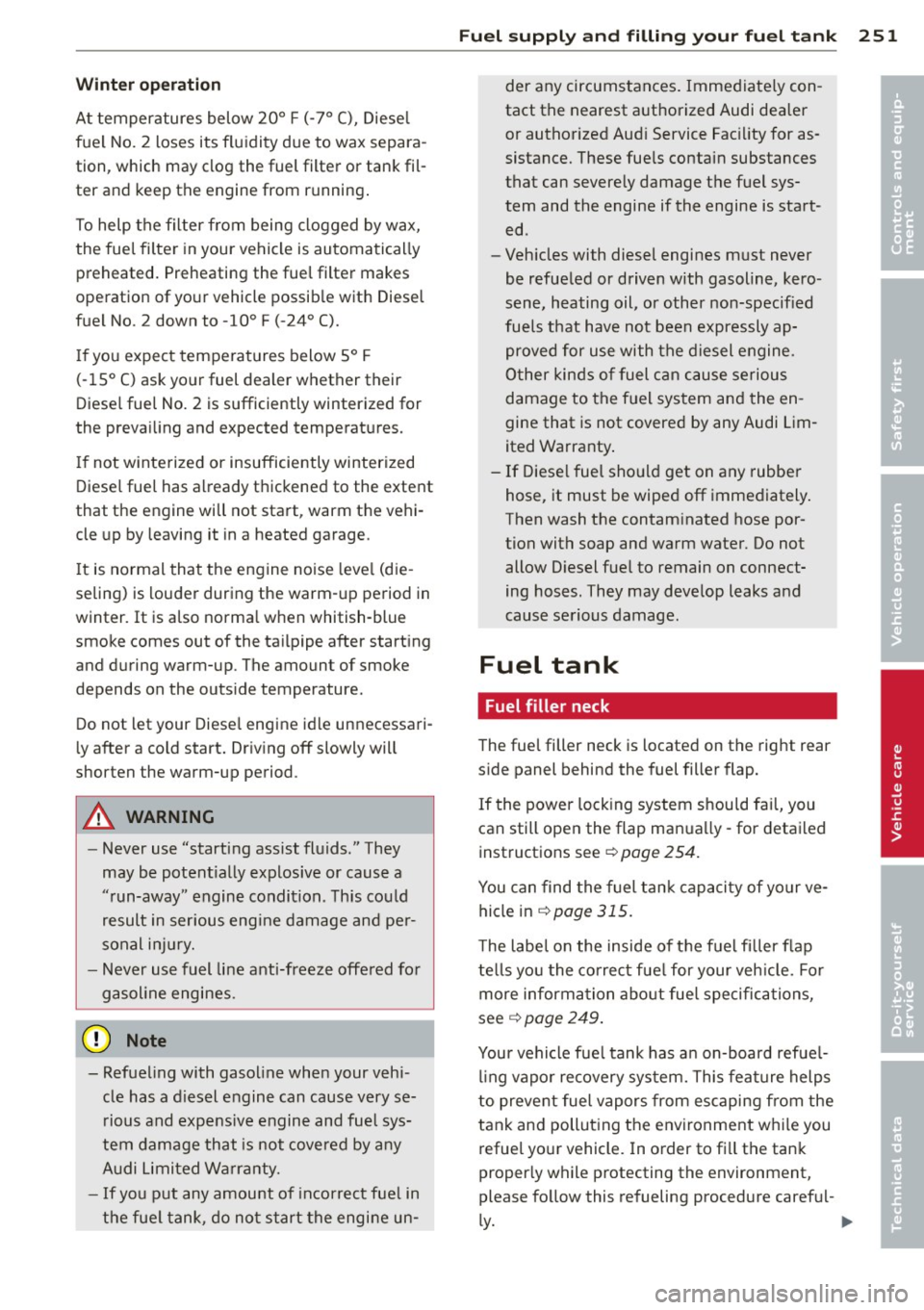
Winter operation
At temperatures below 20° F (-7° C), Diesel
fuel No.
2 loses its fluidity due to wax separa
tion, which may clog the fuel filter or tank fil
ter and keep the engine from running .
To help the filter from being clogged by wax,
the fuel filter in your vehicle is automatically
preheated. Preheating the fuel filter makes
operation of your vehicle possible with Diesel
fuel No . 2 down to -10° F (-24° C).
If you expect temperatures below 5° F
(-15° C) ask your fuel dealer whether their
Diese l fuel No. 2 is sufficiently winterized for
the prevailing and expected temperatures.
If not winterized or insufficiently winterized
Diesel fuel has already thickened to the extent
that the engine will not start, warm the vehi
cle up by leaving it in a heated garage.
It is normal that the engine noise leve l (die
seling) is louder during the warm-up period in
winter.
It is also norma l when whitish-blue
smoke comes out of the tailpipe after start ing
and during warm-up . The amount of smoke
depends on the outs ide temperature.
Do not let your Diese l engine id le unnecessari
ly after a cold start. Driving off slowly will
shorten the warm-up period .
A WARNING
-Never use "starting assist fluids." They
may be potent ially explosive or cause a
"run-away" engine condition. This could
result in serious engine damage and per
sonal injury.
- Never use fuel line anti-freeze offered for
gasoline engines .
0 Note
- Refueling with gasoline when your vehi
cle has a diesel engine can cause very se
rious and expens ive engine and fuel sys
tem damage that is not covered by any
A udi Limited Warranty.
- If you put any amou nt of incorrect fuel in
the fuel tank, do not start the engine un-
-
Fuel supply and filling your fuel tank 251
der any circumstances. Immediately con
tact the nearest authorized Audi dea ler
or authorized Audi Service Fac ility for as
sistance. These fuels contain substances
that can severely damage the fuel sys
tem and the engine if the engine is start
ed .
- Veh icles with diesel engines must never
be refueled or driven with gasoline, kero
sene, heating oil, or other non-specified
fuels that have not been expressly ap proved for use with the diesel engine.
Other kinds of fuel can cause serious
damage to the fuel system and the en
gine that is not covered by any Audi Lim
ited Warranty.
- If Diesel fuel should get on any rubber
hose, it must be wiped off immediately.
Then wash the contaminated hose por
tion with soap and warm water. Do not
allow D iesel fuel to remain on connect
ing hoses . They may develop leaks and
cause serious damage.
Fuel tank
Fuel filler neck
The fuel filler neck is located on the right rear
side panel behind the fuel filler flap.
If the power locking system shou ld fai l, you
can still open the flap manually -for detailed
instructions see¢
page 254.
You can find the fuel tank capacity of your ve
hicle inc::>
page 315.
The label on the inside of the fuel filler flap
tells you the correct fuel for your veh icle. For
more information abo ut fuel specifications,
see c::>
page 249.
Your vehicle fuel tank has an on-board refuel
ling vapor recovery system. This feature helps
to prevent fue l vapors from escaping from the
tank and pollut ing the environment while you
refuel yo ur vehicle. In order to fill the tank
properly while protecting the environment,
please follow this refueling procedure careful-
~-~
•
•
Page 254 of 340

252 Fuel supply and filling your fuel tank
_&. WARNING
Under normal operating conditions, never
carry additional fuel containers in your car .
Gas canisters and other containers used to
transport fuel can be dangerous. Such con
tainers, full or empty, may leak and could
cause afire in a collision. If you must
transport fuel to use for your lawn mower,
snow blower, etc., be very careful and al
ways observe local and state laws regard
ing the use, transportat ion and storage of
such fuel containers. Make certain the con
tainer meets industry standards (ANSI/
ASTM F8S2 -86).
(D Note
Never drive your vehicle until the fuel tank
is completely empty. The irregular supp ly
of fuel can cause misfiring . Gasoline could
enter the exhaust system and damage the
catalyt ic converter.
Refuelling
Fig . 232 Right rear vehicle side : Open ing t he fue l filler
fl ap
Fig. 233 Fu el cap hooked on the opened fue l filler fl ap
When adding fuel, the ignition and any cellu
lar phones in the vehicle must be switched
off . When activating the central locking, the fuel
filler flap is automatically unlocked or
locked. Refuel the vehicle with the ignition
turned
off.
Taking the fuel cap off
.,. To open the fue l filler f lap, press on the left
side of the flap¢
fig. 232 -arrow-.
.,. Unscrew fue l filler cap counter-clockwise
and hang it on the fuel filler flap ¢
fig. 233.
.,. Check the label on the inside of the fuel fill
er flap to determine if the vehicle must be
fueled with gasoline or diesel fuel.
Refuelling procedure
.,. Insert the fuel nozzle from the gasoline
pump into the fuel filler neck as far as it wi ll
go .
.,. Select a medium refuelling rate so that the
nozzle switches off automatically when the
tank is fu ll.
Putting the fuel cap back on
.,. After filling your tank, twist the fuel filler
cap clockwise as far as it wi ll go.
.,. Close the fuel filler flap.
T o avoid fuel spilling or evaporating from the
fuel tank always close fuel filler cap proper ly
and completely. An improperly closed fuel fill
er cap may also cause the MIL lamp¢
page 27
to come on (only vehicles with gasoline en
gine) .
_&. WARNING
Improper refueling or handling of fuel can
cause fire, explosion and severe burns.
- Fuel is highly flammable and can cause
severe bu rns and other injuries.
- Failure to shut the engine off while refu
eling and/or to insert the pump nozzle
fu lly into the fuel filler neck could cause
fuel to spray out of filler neck or to over
f low . Fu el spray and overflowing fue l can
cause a fire.
- Never use a cellular telephone while re
fue ling. The electromagnetic radiat ion
can cause sparks that can ignite fuel va
pors and cause a fire .
Page 256 of 340
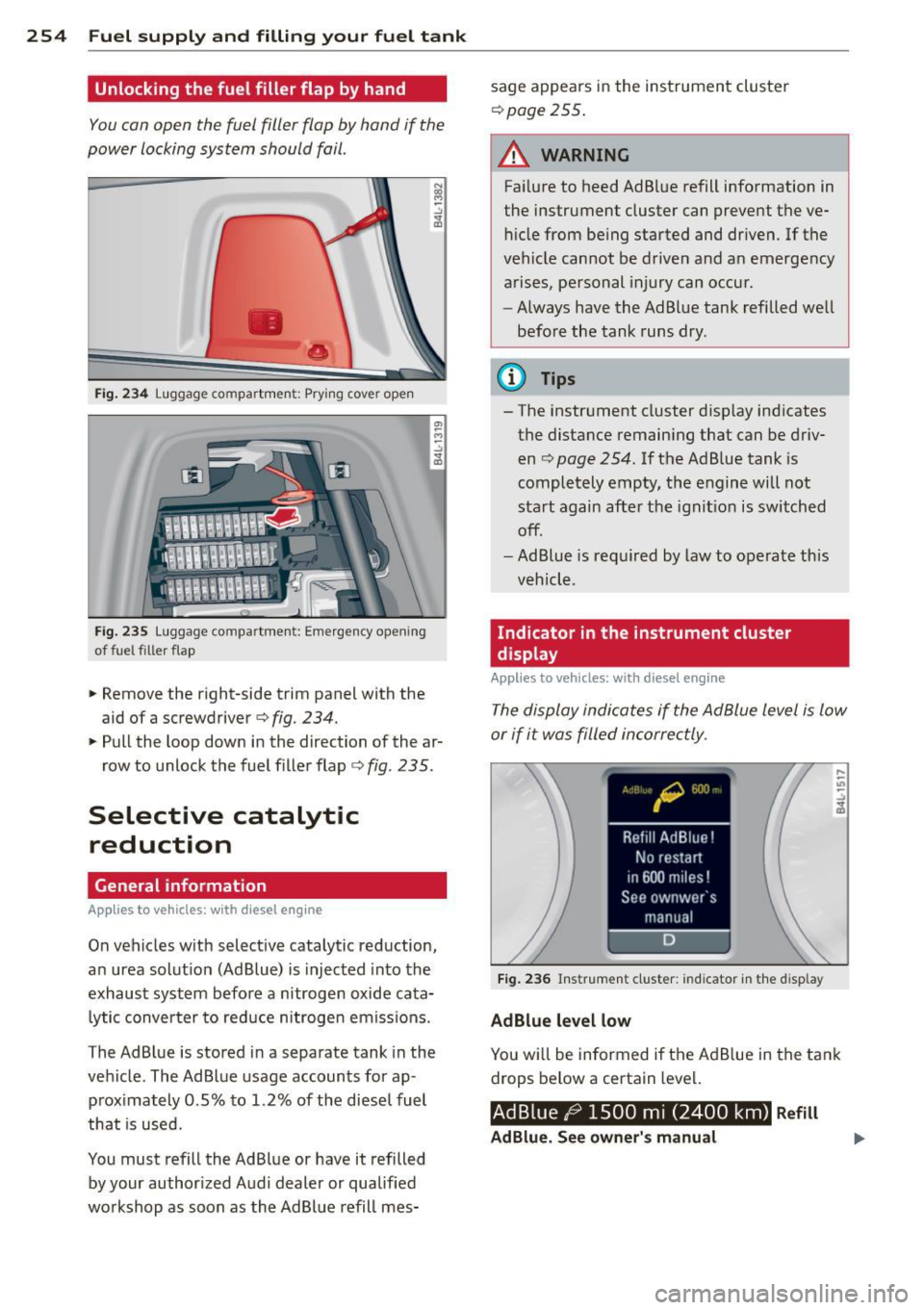
254 Fuel supply and filling your fuel tank
Unlocking the fuel filler flap by hand
You can open the fuel filler flap by hand if the
power locking system should fail .
•
Fig. 234 Luggag e compart men t: Pry ing cover open
Fig. 235 Luggage compartmen t: Eme rgency open ing
of fuel filler flap
.. Remove the right-side trim panel with the
aid of a screwdriver
c:> fig. 234.
.. Pull the loop down in the direction of the ar
row to unlock the fuel f iller flap
c:> fig. 235.
Selective catalytic
reduction
General information
Applies to vehicles: with diesel engine
On vehicles with selective catalytic reduction,
an urea solution (Ad Blue) is injected into the
exhaust system before a nitrogen oxide cata lytic converter to reduce nitrogen emiss ions.
The AdBlue is stored in a separate tank in the
vehicle. The AdBlue usage accounts for ap
proximately 0.5% to 1.2% of the diesel fuel
that is used.
You must refill the Ad Blue or have it refilled
by your author ized Audi dealer or qualified
workshop as soon as the AdBlue refill mes- sage appears
in the instrum ent cluster
r=>page 255.
.&_ WARNING
-
Failure to heed AdBlue refill information in
the instrument cluster can prevent the ve hicle from being started and driven. If the
vehicle cannot be driven and an emergency
arises, personal injury can occur.
- Always have the AdBlue tank refilled well
before the tank runs dry.
(D Tips
- The instrument cluster disp lay ind icates
the distance remaining that can be driv
en
r=> page 254. If the AdBlue tank is
completely empty, the engine will not
start again after the ignit ion is switched
off.
- AdBlue is required by law to operate this
vehicle.
Indicator in the instrument cluster
display
Appl ies to vehicles: with diesel engine
The display indicates if the Ad Blue level is low
or if it was filled incorrectly .
Fig. 236 Instrument cluster: indicator in the display
AdBlue level low
You will be informed if the Ad Blue in the tank
drops below a certain level.
AdBlue l;) 1500 mi (2400 km) Refill
AdBlue. See owner's manual